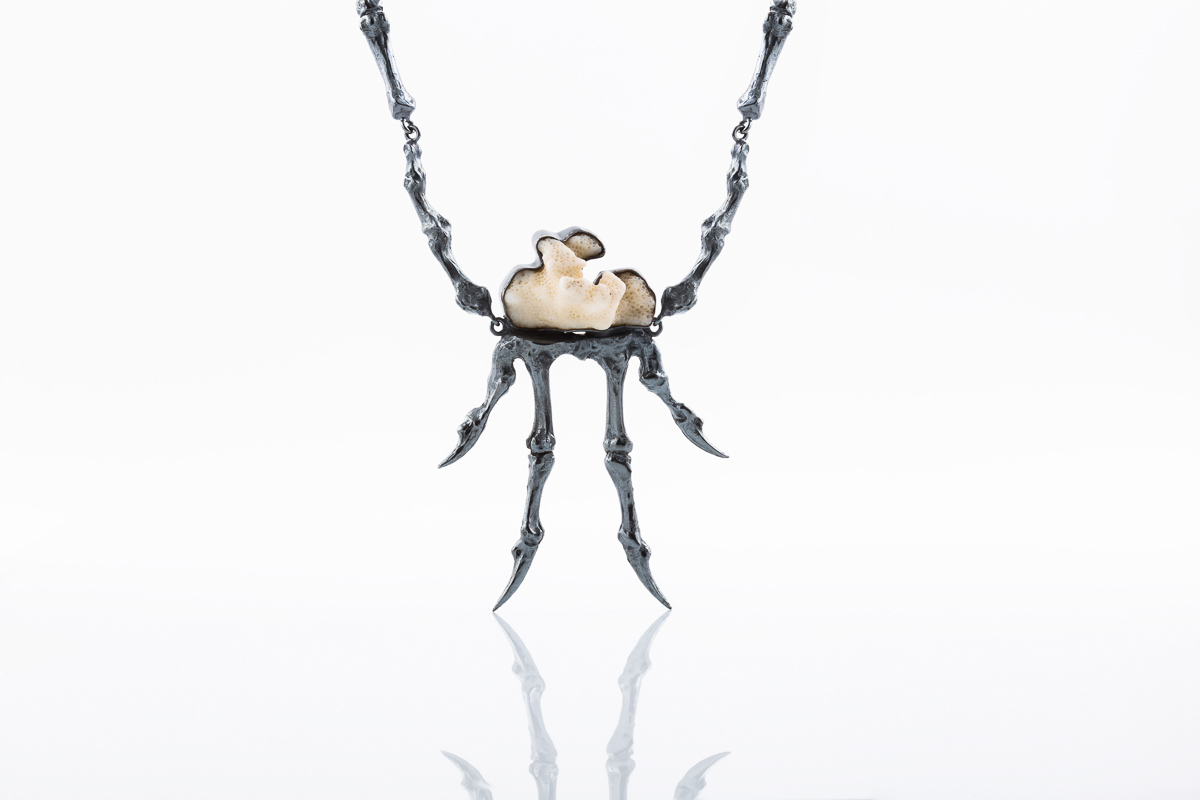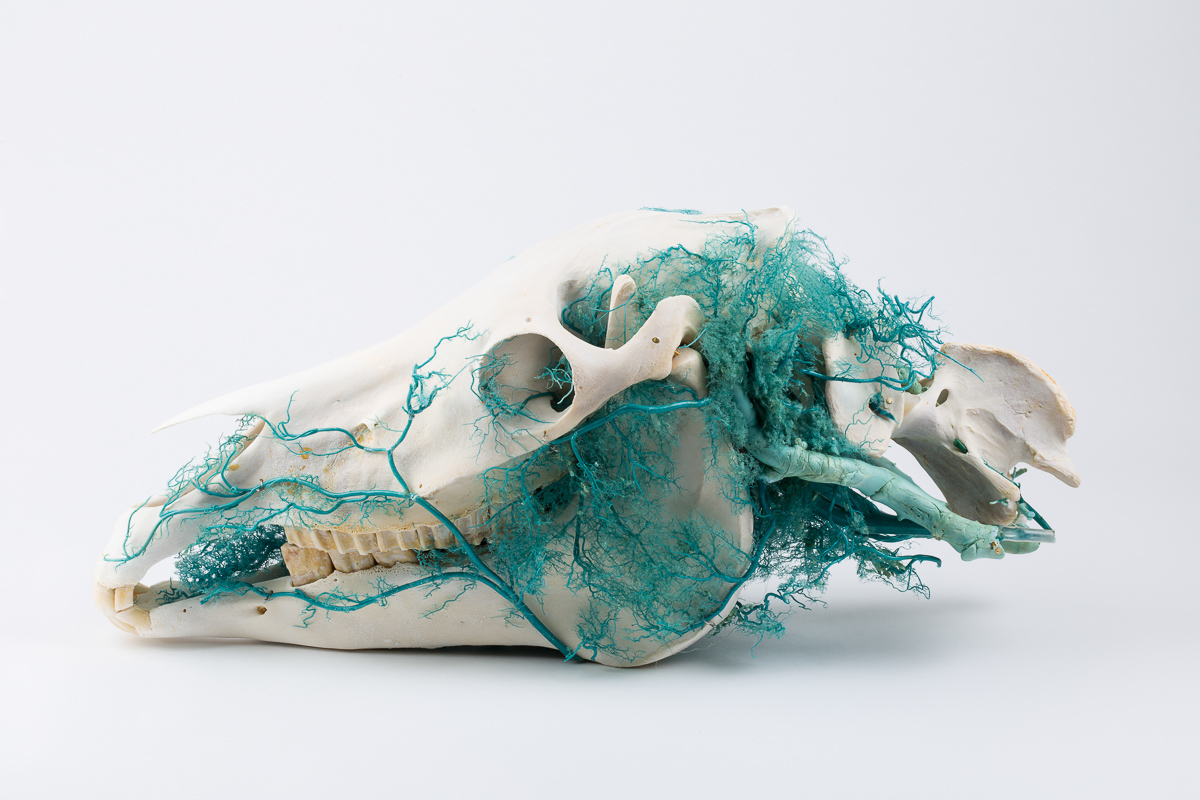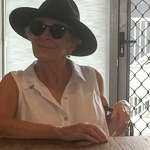
Tineke Van der Eecken, Tread lightly #2 , 2021, methylacrylate, vascular corrosion cast of pony front hoof in methyl methacrylate by Christophe Casteleyn & Dr Sofie Muylle, Department of
Morphology, Ghent University. 230 x 55 x 60 mm, and wire sculpture in silver by Tineke Van der Eecken. Photography Yasmin Eghtesadi.
Koral Ward reflects on the flow of matter and form that brings together life and death in the work of Tineke Van der Eecken.
Writing is the creative current that has streamed through life no matter what other art forms I have pursued. I love to carve and hone to the beautiful bone of language, whether in my own work or that of others. From time to time, and at present, I write ekphrastic compositions in response to visual artworks and their makers for exhibitions and catalogues. In 2019, Garland published my piece in response to the photography of Guy Vinciguerra, in his exhibition Sacred Places.
Tineke Van der Eecken is a Belgian born artist who combines jewellery, micro sculptures, poetry and photography in her multidisciplinary practice to articulate narratives of place. She focuses on the preciousness of our living planet and our role in preserving it. She draws a connecting line from the mineral substances of the earth, through to tributary forms of the living planet, and of human beings themselves. She traces the threads of what connects us and exposes where our co-existence makes this living, breathing planet fragile. She expresses the preciousness using silver and gold, and castings of West Australian organic plant and animal form in precious metals. Tineke’s new work can be seen in the Mundaring Arts Centre, WA in November 2021 as part of IOTA21. The exhibition is called Tributaries:
Tributaries are meandering arterial waterways that ebb and flow, moving through the environment into and out of the bodies of rivers, constant but changing entities. Such is the paradoxical way of the world, and of beings in the world.
The shape and movement of arterial, arboreal and dendritic systems permeate this world. As they flow, they gain ground, deliver and exchange nutrients. Drawing up through roots they create new growth. As they receive so they transmit. They seek level and balance and form. They build environment. Such systems provide analogues to the human process, most clearly in creative work.

Tineke Van der Eecken, Anthropocene Necklace, 2021, recycled silver (oxydised), casts of found kangaroo knuckle and beach-combed coral, pendant 80 x 55 x 10mm and 58cm chain. Photography Yasmin Eghtesadi.
Environment is the terrain of river and lake, inlet and wetland, ocean and reef, canyon and mountain. It is the deep, the internal spaces of land and water, the residual elements of ancient forms from the depths of crystalline time. It is the air, we breathe the breath of the ancients.
Environment is our intimate, “inborn” landscape: bodyscapes and their systems of skeleton and vein; mindscapes, their cognitive processes and the underlying kinships of ancestral psychic lineage. Bone and blood, rock and river; flora, fauna, and human, we ravel and unravel habitat in the great tangle of evolution.
Tineke Van der Eecken explores narratives of environment and place. She re-collects impressions and inheritances, gathers lived experiences and disparate aspects of practice, and resolves them in these discrete moments of lived expression: her works. As terrain dictates the path of water, the artist shifts direction. She is tapping into the systems that flow into, through and beyond her into forms. Her forms express a poetics of elemental matter, subject and object of the work, her place of work. They are the deposits of her familial roots in the traditions of Flemish lace reconstituted in metals.
The artist creates from what life already knows about itself, its living innate shapes, and always already existent materials. All materials are organic, there is nothing available to us that does not come from the earth, the natural and the fabricated, the found, the sought and the wrought. Tineke’s objects are organic in matter and in form. Stones cluster elegantly where streams deposit them, tides arrange elements in strings of flotsam and jetsam.
For Tineke, scientific observation and technique are soul-mates to poetry and making. Corrosion as a technique of casting forms exposes veins and dendritic nerve paths, transforming them into plastinate models. Halted of movement and wetness, they describe elegant line-drawings in the air. We touch the ground fleetingly with the tips of our hooves. How sharply poignant is this prancing suggestion of the dance macabre and the spirit horse of the apocalypse.

Christophe Casteleyn & Dr Sofie Muylle, Regeneration, 2021, vascular corrosion cast of equine head with skull, polyutherane, 60 x 25 x 20cm. Photography Yasmin Eghtesadi.
A horse skull inspires awe in its proper sense of equal parts horror and sublimity. Life threads grow through it like trees through rocks, like coral through reef.
The affect of the works ranges from delight to confrontation, invoking visceral reactions. We can look upon Tineke’s handsome skulls and bones and sculptural forms as objects of contemplation, as memento-mori: warnings and admonishments to remember the natural order of emergence and demise. And we can look upon these objects as memento-vivi; death is inevitable because there is life. We can wear her fine objects of adornment as talismanic charms to remind us. Remember to live.
The advancement of creative work requires moments of surprise that disrupt the expected continuum. Unexpected shifts occur and results appear that could not have been predicted. We are uncertain as to what we are looking at. Uncertain the mind stands open, in this aporia stands wonder. Our world is showing us such moments, raw and confronting.
The artist’s drive is to preserve a vulnerable and ephemeral world in a time of cataclysmic change. Rituals of making and presentation may work toward ensuring continuance, protect us from threats, and breaks, and loss. If we maintain rituals we might hold the world on a level. We might hold off the oldest fears—of the infinite, and the oblivion of forgetting even that there was anything there to remember.
Ritual is the practice of memorialising, memorising, and re-remembering, it allows circumstances in which to share communal experiences. A sacred space is a fixed point in a shifting world, a point where existence coheres, where meaning arises. A gathering place, a space set aside, discrete for purpose, for exhibition.
This is tributary work. It teases out geographical, biological and ancestral pathways. It honours the binding sameness of ourselves at a cellular level with all other manifestations of existence, as one entirety, ebbing and flowing to and from the source of all.
You can read the catalogue for this exhibition here.
About Koral Ward
 Dr Koral Ward is a writer and printmaker. She has been a theatrical costumier and performance poet, and is knowledgeable about one vast yet infinitesimal thing about which she published ‘Augenblick: The Concept of the Decisive Moment in 19th and 20th Century Western Philosophy’ in 2008. In the present moment, she is writing a sequel which connects the Western philosophical rendering of the Moment to the Eastern, most notably found in Zen Buddhism. She lives in Fremantle WA and is vice-chair of Sustainable Housing for Artists and Creatives Cooperative Inc.
Dr Koral Ward is a writer and printmaker. She has been a theatrical costumier and performance poet, and is knowledgeable about one vast yet infinitesimal thing about which she published ‘Augenblick: The Concept of the Decisive Moment in 19th and 20th Century Western Philosophy’ in 2008. In the present moment, she is writing a sequel which connects the Western philosophical rendering of the Moment to the Eastern, most notably found in Zen Buddhism. She lives in Fremantle WA and is vice-chair of Sustainable Housing for Artists and Creatives Cooperative Inc.


